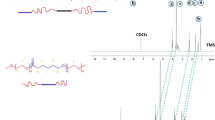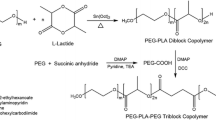Abstract
Block copolymers of Methoxy poly(ethylene glycol)-block-poly(ε-caprolactone) bearing ketone groups (MPEG-b-P(CL-co-OPD)) are synthesized and evaluated for its potential to form micelles containing doxorubicin (DOX), a representative anticancer drug, by using an in vitro method based on membrane dialysis to emulate drug release in vivo. The 1H NMR spectra of the prepared block copolymers in D2O solution exhibit peaks due to the P(OPD-co-CL) in decreased intensity, indicates that the polymers form micelle particles containing the hydrophilic segments in their external parts. The CMC of the copolymer decrease with an increase in the content of ketone groups in the hydrophobic chain. Drug-free and drug-loaded solutions of structurally related copolymers indicate the polymeric aggregation into micellar-type constructs. The size of the drug-loaded micelles is found to be larger than corresponding drug-free micelles. The release rate of MPEG-b-PCL micelles is faster than MPEG-b-P(OPD-co-CL) micelles in pH 7.4 buffered solution and they have a similar release rate in pH 5.0 buffered solution. This study, therefore, confirms the potential of a novel functional block copolymers, Methoxy poly(ethylene glycol)-block-poly(ε-caprolactone) bearing ketone Groups, for the formation of polymeric micelles for drug delivery.





Similar content being viewed by others
References
Stenzel MH. RAFT polymerization: an avenue to functional polymeric micelles for drug delivery. Chem Commun. 2008;30:3486–503.
Sheng Y, Liu CS, Yuan Y, Tao XY, Yang F, Shan XQ, et al. Long-circulating polymeric nanoparticles bearing a combinatorial coating of PEG and water-soluble chitosan. Biomaterials. 2009;30:2340–8.
Sun TM, Du JZ, Yan LF, Mao HQ, Wang J. Self-assembled biodegradable micellar nanoparticles of amphiphilic and cationic block copolymer for siRNA delivery. Biomaterials. 2008;29:4348–55.
Lo CL, Huang CK, Lin KM, Hsiue GH. Mixed micelles formed from graft and diblock copolymers for application in intracellular drug delivery. Biomaterials. 2007;28:1225–35.
Son YJ, Jang JS, Cho YW, Chung H, Park RW, Kwon IC, et al. Biodistribution and anti-tumor efficacy of doxorubicin loaded glycol-chitosan nanoaggregates by EPR effect. J Control Release. 2003;91:135–49.
Canciello M, Maglio G, Nese G, Palumbo R. Poly(e-caprolactone)-poly(oxyethyl- ene) multiblock copolymers bearing along the chain regularly spaced pendant amino groups. Macromol Biosci. 2007;7:491–9.
Taniguchi I, Kuhlman WA, Mayes AM, Griffith LG. Functional modification of biodegradable polyesters through a chemoselective approach: application to biomaterial surfaces. Polym Int. 2006;55:1385–97.
Hu XL, Liu S, Chen XS, Mo GJ, Xie ZG, Jing XB. Biodegradable amphiphilic block copolymers bearing protected hydroxyl groups: synthesis and characterization. Biomacromolecules. 2008;9:553–60.
Mahmud A, Xiong XB, Lavasanifar A. Novel self-associating poly(ethylene oxide)-block-poly(ε-caprolactone) block copolymers with functional side groups on the polyester block for drug delivery. Macromolecules. 2006;39:9419–28.
Hu XL, Chen XS, Xie ZG, Liu S, Jing XB. Synthesis and characterization of amphiphilic block copolymers with allyl side-groups. J Polym Sci Part A: Polym Chem. 2007;45:5518–28.
Wang L, Jia XH, Liu XH, Yuan Z, Huang JX. Synthesis and characterization of a functionalized amphiphilic diblock copolymer: MePEG-b-poly(DL-lactide-co-RS-β-malic acid). Colloid Polym Sci. 2006;285:273–81.
Xiong XB, Mahmud A, Uluda H, Lavasanifar A. Multifunctional polymeric micelles for enhanced intracellular delivery of doxorubicin to metastatic cancer cells. Pharm Res. 2008;25:2555–66.
Mahmud A, Xiong XB, Lavasanifar A. Development of novel polymeric micellar drug conjugates and nano-containers with hydrolyzable core structure for doxorubicin delivery. Eur J Pharmaceut Biopharmaceut. 2008;69:923–34.
Kataoka K, Matsumoto T, Yokoyama M, Okano T, Sakurai Y, Fukushima S, et al. Doxorubicin-loaded poly(ethylene glycol)–poly(ß-benzyl-L-aspartate) copolymer micelles: their pharmaceutical characteristics and biological significance. J Control Release. 2000;64:143–53.
Tian Y, Ravi P, Bromberg L, Hatton TA, Tam KC. Synthesis and aggregation behavior of pluronic F87/poly(acrylic acid) block copolymer in the presence of doxorubicin. Langmuir. 2007;23:2638–46.
Li GY, Song S, Guo L, Ma SM. Self-assembly of thermo- and pH-responsive poly(acrylic acid)-b-poly(N-isopropylacrylamide) micelles for drug delivery. J Polym Sci Part A: Polym Chem. 2008;46:5028–35.
Yin HQ, Bae YH. Physicochemical aspects of doxorubicin-loaded pH-sensitive polymeric micelle formulations from a mixture of poly(L-histidine)-b-poly(L-lactide)-b-poly(ethylene glycol). Eur J Pharmaceut Biopharmaceut. 2009;71:223–30.
Ye YQ, Chen FY, Wu QA, Hu FQ, Du YZ, Yuan H, et al. Enhanced cytotoxicity of core modified chitosan based polymeric micelles for doxorubicin delivery. J Pharm Sci. 2009;98:704–12.
Lu DX, Wen XT, Liang J, Gu ZW, Zhang XD, Fan YJ. A pH-sensitive nano drug delivery system derived from pullulan/doxorubicin conjugate. J Biomed Mater Res Part B: Appl Biomater. 2009;89B:177–83.
Bae Y, Diezi TA, Zhao A, Kwon GS. Mixed polymeric micelles for combination cancer chemotherapy through the concurrent delivery of multiple chemotherapeutic agents. J Control Release. 2007;122:324–30.
Kim DG, Lee ES, Oh KT, Gao ZG, Bae YH. Doxorubicin-loaded polymeric micelle overcomes multidrug resistance of cancer by double-targeting folate receptor and early endosomal pH. Small. 2008;4:2043–50.
Sethuraman VA, Lee MC, Bae YH. A Biodegradable pH-sensitive micelle system for targeting acidic solid tumors. Pharmaceut Res. 2008;25:657–66.
Huang CK, Lo CL, Chen HH, Hsiue GH. Multifunctional micelles for cancer cell targeting, distribution imaging, and anticancer drug delivery. Adv Funct Mater. 2007;17:2291–7.
Shuai XT, Nasongkl HAN, Kim S, Gao JM. Micellar carriers based on block copolymers of poly(q-caprolactone) and poly(ethylene glycol) for doxorubicin delivery. J Control Release. 2004;98:415–26.
Lin JP, Zhu JQ, Chen T, Lin SL, Cai CH, Zhang LS, et al. Drug releasing behavior of hybrid micelles containing polypeptide triblock copolymer. Biomaterials. 2009;30:108–17.
Yang XQ, Chen YH, Yuan RX, Chen GH, Blanco E, Gao JM, et al. Folate-encoded and Fe3O4-loaded polymeric micelles for dual targeting of cancer cells. Polymer. 2008;49:3477–85.
Jia ZF, Wong LJ, Davis TP, Bulmus V. One-pot conversion of RAFT-generated multifunctional block copolymers of HPMA to doxorubicin conjugated acid- and reductant-sensitive crosslinked micelles. Biomacromolecules. 2008;9:3106–13.
Chytil P, Etrych T, Konák C, Sírová M, Mrkvan T, Boucek J, et al. New HPMA copolymer-based drug carriers with covalently bound hydrophobic substituents for solid tumour targeting. J Control Release. 2008;127:121–30.
Lee YH, Park SY, Mok HJ, Park TG. Synthesis, characterization, antitumor activity of pluronic mimicking copolymer micelles conjugated with doxorubicin via acid-cleavable linkage. Bioconjugate Chem. 2008;19:525–31.
Yokoyama M, Fukushima S, Uehara R, Okamoto K, Kataoka K, Sakurai Y, et al. Characterization of physical entrapment and chemical conjugation of adriamycin in polymeric micelles and their design for in vivo delivery to a solid tumor. J Control Release. 1998;50:79–92.
Latere JP, Lecomte P, Dubois P, Jérôme R. 2-Oxepane-1, 5-dione: a precursor of a novel class of versatile semicrystalline biodegradable (co)polyesters. Macromolecules. 2002;35:7857–9.
He YY, Dai WF, Gu CH, Lang MD. Synthesis and characterization of amphiphilic functional block poly(ε-caprolactonne) bearing ketone groups. J Clin Rehab Tissue Eng Res. 2009;13:6721–4.
Fairley N, Hoang B, Allen C. Morphological control of poly(ethylene glycol)-block-poly(ε-caprolactone) copolymer aggregates in aqueous solution. Biomacromolecules. 2008;9:2283–91.
Kharakoz DP. Partial molar volumes of molecules of arbitrary shape and the effect of hydrogen bonding with water. J Solution Chem. 1992;21:569–95.
Meot-Ner M, Scheiner S, Yu WO. Ionic hydrogen bonds in bioenergetics. 3 proton transport in membranes, modeled by ketone/water clusters. J Am Chem Soc. 1998;120:6980–90.
Katz JJ, Ballschmiter K, Garcia-Morin M, Strain HH, Uphaus RA. Electron papamagnetic resonance of chlorophyll-water aggregates. Pans. 1968;60:100–7.
Cammas S, Matsumoto T, Okano T, Sakurai Y, Kataoka K. Design of functional polymeric micelles as site-specific drug vehicles based on poly(a-hydroxy ethylene oxide-co-p-benzyl L-aspartate) block copolymers. Mater Sci Eng C. 1997;4:241–7.
Acknowledgment
This research was supported by the National Natural Science Foundation of China (20674019 and 20804015), “Shu Guang” Project of Shanghai Municipal Education Commission, Specialized Research Fund for the Doctoral Program of Higher Education (20060251015, 200802511021), the Natural Science Foundation of Shanghai, (08ZR1406000), Shanghai Key Laboratory Project (08DZ2230500) and Shanghai Leading Academic Discipline Project (B502).
Author information
Authors and Affiliations
Corresponding author
Rights and permissions
About this article
Cite this article
Yueying, H., Yan, Z., Chunhua, G. et al. Micellar carrier based on methoxy poly(ethylene glycol)-block-poly(ε-caprolactone) block copolymers bearing ketone groups on the polyester block for doxorubicin delivery. J Mater Sci: Mater Med 21, 567–574 (2010). https://doi.org/10.1007/s10856-009-3887-x
Received:
Accepted:
Published:
Issue Date:
DOI: https://doi.org/10.1007/s10856-009-3887-x




